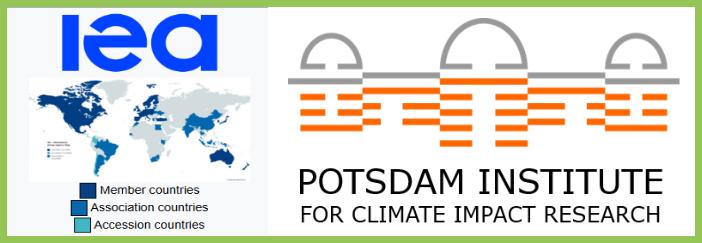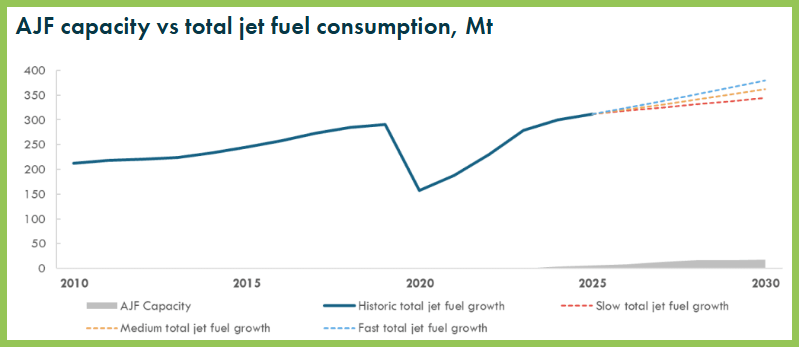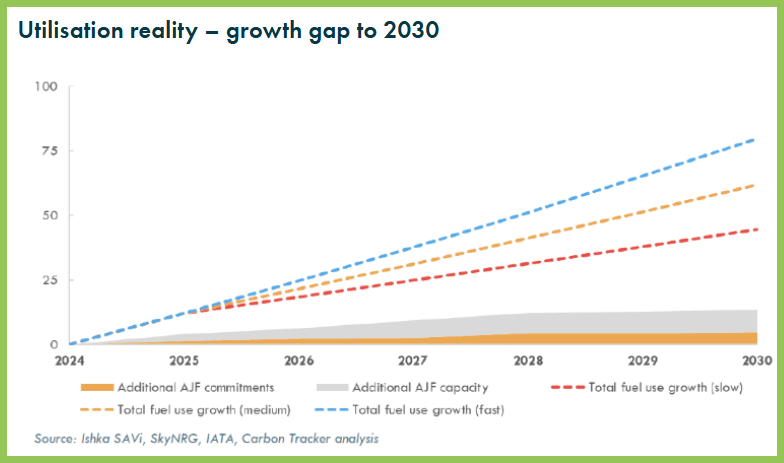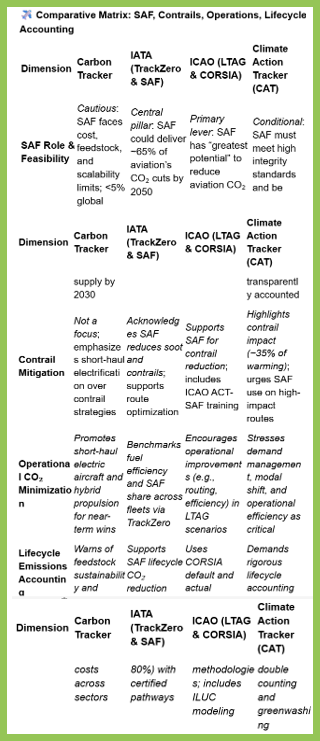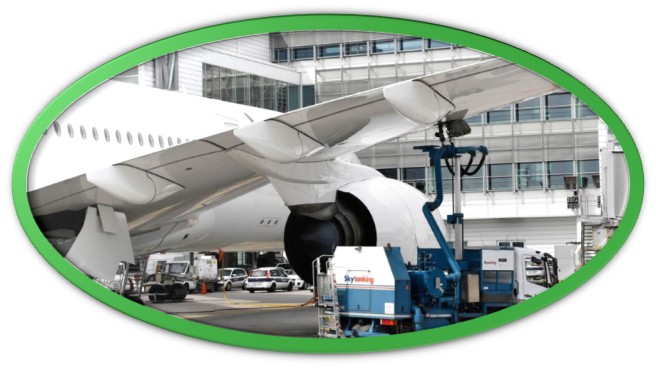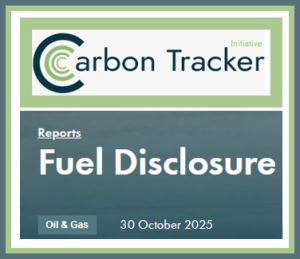Is SAF the answer to Net Xero Carbon Emissions 2050 goal???
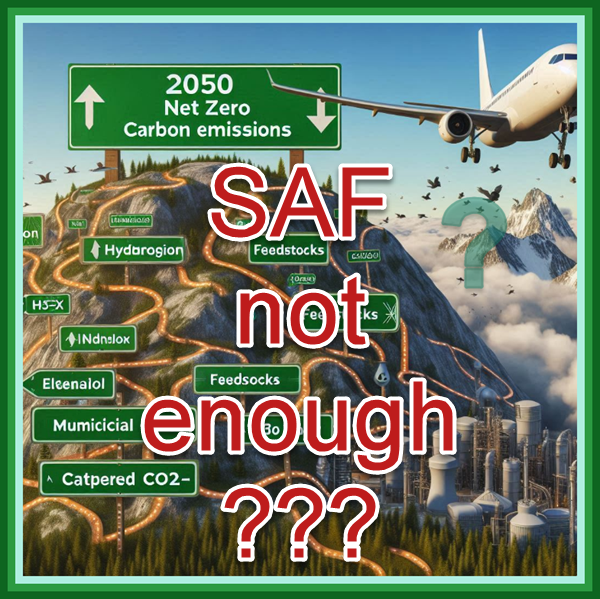
SAF is THE preferred, only(? )Pathway to Net Zero Carbon Emissions. Indeed it is the primary focus of ICAO, IATA[1], EASA/EU and FAA/DoT[2]. AIN has published a credible article, titled, Report Sees Minimal Role for SAF in Cutting Emissions, suggesting that SAF may not be what it is cracked up to be.
CarbonTracker (CT), the source of this strong opinion, is widely regarded as a credible and influential think tank in climate finance. This non-profit think tank was founded in London by UK fund manager Mark Campanale—
CT has focused on the intersection of climate science and financial markets. Its stature derives, in part, from the collaboration work with respected institutions like the International Energy Agency[3] (IEA) and Potsdam Institute for Climate Impact Research, grounding its work in robust climate modeling and financial analysis.
More bona fides:
-
- Mark Carney, former Governor of the Bank of England
- Norway’s sovereign wealth fund, which used Carbon Tracker’s analysis to justify divestment from fossil fuels.
- Its Unburnable Carbon (2011, 2013)reports—are considered foundational in climate finance discourse.
- Carbon Tracker’s reports are known for quantitative rigor, using asset-level financial modeling (e.g., CTI-PALEM) to assess transition risks in sectors like oil, gas, steel, and power generation.
- Their work is often cited in financial audits, investor briefings, and regulatory discussions, including responses submitted jointly with organizations like Ceres and the Climate Accounting Project.
With that background, here are Fuel Disclosure’s major conclusions—
- Near-term shortfall: By 2030, potential Alternative jet fuels (AJF) supply covers only a small share of total jet fuel consumption and fails to offset its growth.
- Sustainability criteria: Not all “SAF” is sustainable – several pathways carry risks to nature and climate.
- Seven hurdles to scale:
- Costs and price premiums;
- regulatory uncertainty;
- lack of long-term offtake;
- weak bankability;
- feedstock availability;
- feedstock sustainability;
- opportunity costs.
- Right-sizing roles: AJF has a role, but a smaller one, mostly in long-haul flight; short-haul decarbonisation can proceed sooner with zero-emission and hybrid-electric aircraft, alongside operational measures.
These major premises are supported by the following two charts:
So much of what surrounds this technological, developmental and environmental sector is hard to take for granted; debate/review MUST ADDRESS TC’s analysis. If the think tank’s conclusions are valid, then ICAO CORSIA MUST review the degree to which SAF is relied upon as its primary pathway. A reference library for such a policy discussion might include the following reports:
- Contrails
- ICAO #42 report says CONTRAIL policies may avoid >90% of aviation-induced warming by 2050 From EPA Acid Rain lesson time to review CORSIA
- IATA’s STUDY of Contrails is MOST INSTRUCTIVE
- SAF may be the solution to CONTRAILS
- Scourge of CONTRAILs being attacked by EASA and FAA
- Can Civil Aviation decrease CONTRAILS now???
- Electric Powerplant
- Reports/Assessments
- Hydrogen Option(S)
- Redesign Of Traditional Powerplants
- SAF Alternatives
- Swiss Alchemy creates SAF with the SUN ???
- Operational Alternatives
- Emirates’ Green Operating Procedures start with the Cockpit
Initial environmental efforts are not always successful. Acid Rain, for example, was caused by the use of tall smokestacks to disperse their emissions. It was later found that “actually tall stacks generally disperse pollutants over greater distances than shorter stacks and provide pollutants greater time to react in the atmosphere to form ozone and particulate matter.” Statutes and EPA rules moved to scrubbers to control SO2 and post-combustion controls to capture NOx emissions.
Perhaps it is time for ICAO and the world’s aviation community to review options based on the CT Fuel Disclosure report. Since the discussions and vote setting Carbon Offsetting and Reduction Scheme for International Aviation (CORSIA), BILLIONS of dollars have been invested in a plethora of potential CO2 solutions some of which do not depend on SAF, in whole or in part. Perhaps it is time for the global aviation community to return to Montreal and ASSESS WHAT OPTION(S) MAY HAVE THE MOST LIKELY RESULTS IN ATTAINING NET ZERO CARBON EMISSIONS 2050.
Report Sees Minimal Role for SAF in Cutting Emissions
Carbon Tracker urges investment in electric propulsion for short-haul flights
Carbon Tracker’s latest report downplays expectations for increased use of sustainable aviation fuel before 2030. © Munich Airport
By Charles Alcock • Managing Editor
October 31, 2025
SUSTAINABLE AVIATION FUEL (SAF) will make only a marginal contribution to reducing aircraft emissions before 2030, according to a new report published yesterday by Carbon Tracker. The UK-based independent financial think tank’s “Fuel Disclosure” report concluded that alternatives to jet-A are “unlikely to make a significant dent” in emissions this decade.
The group’s analysts concluded that high costs and limited feedstocks will curtail the impact of SAF. “EVEN IF ALL EXISTING, UNDER DEVELOPMENT, AND ANNOUNCED PROJECTS OPERATE AT FULL CAPACITY, [SAF] PRODUCTION WOULD ONLY SUPPLY AROUND 5% OF GLOBAL JET FUEL DEMAND AND MEET LESS THAN HALF OF THE EXPECTED GROWTH IN TOTAL JET FUEL CONSUMPTION,” Carbon Tracker concluded.
Apart from high production and distribution costs for SAF, the report said that perceived technology, feedstock, and policy risks are constraining funding for the sector, which the report defines as “weak bankability.” Other factors identified as hurdles to progress include regulatory uncertainty, competition for feedstocks with other sectors, and uncertainty over how much SAF aircraft operators will buy, resulting in revenue uncertainty for producers.
“On top of high costs, offtaker hesitation, and financing constraints, most alternative jet fuels are also saddled with a handful of environmental downsides,” commented Saidrasul Ashrafkhanov, lead author for the report. “These fuels may someday have a larger role in decarbonizing aviation, but the burden of proof is on the industry to show that it can find a pathway that will deliver alternative jet fuel that’s at once sustainable, abundant, and feasible.”
CARBON TRACKER IS URGING COMPANIES TO “RIGHT-SIZE” THE ROLE OF SAF IN THEIR BUSINESSES, PRIORITIZING “PATHWAYS WITH ROBUST SUSTAINABILITY CREDENTIALS AND CLEARER COST TRAJECTORIES” WHILE AVOIDING “OPTIONS WITH WEAK LIFE CYCLE PERFORMANCE OR MATERIAL NATURE/FOOD SECURITY RISKS.” The company argued that for flights on routes of less than 500 kilometers (270 nm), THE PRIORITY SHOULD BE ON INVESTING IN BATTERY-ELECTRIC, HYDROGEN-ELECTRIC, AND HYBRID-ELECTRIC AIRCRAFT.
Sustainability specialists like 4Air are focused on helping aircraft operators, airports and other stakeholders to pursue multiple components towards decarbonization. According to 4Air, in addition to SAF, these will include carbon offsets, the introduction of new aircraft and propulsion technology (fleet renewal and electrification), and improvements to infrastructure and operational efficiencies (including air traffic management).
[1] IATA projects that SAF will likely deliver around 65–80% of the aviation sector’s CO₂ cuts by 2050. However, IATA also supports complementary strategies like operational efficiency and new propulsion technologies.
[2] SAF in #47’s Administration has a new first name—SYNTHETIC.
[3] The International Energy Agency (IEA) is a Paris-based autonomous intergovernmental organization, established in 1974, that provides policy recommendations, analysis and data on the global energy sector.[3] The 32 member countries and 13 association countries of the IEA represent 75% of global energy demand. The IEA was set up under the framework of the Organisation for Economic Co-operation and Development (OECD).

